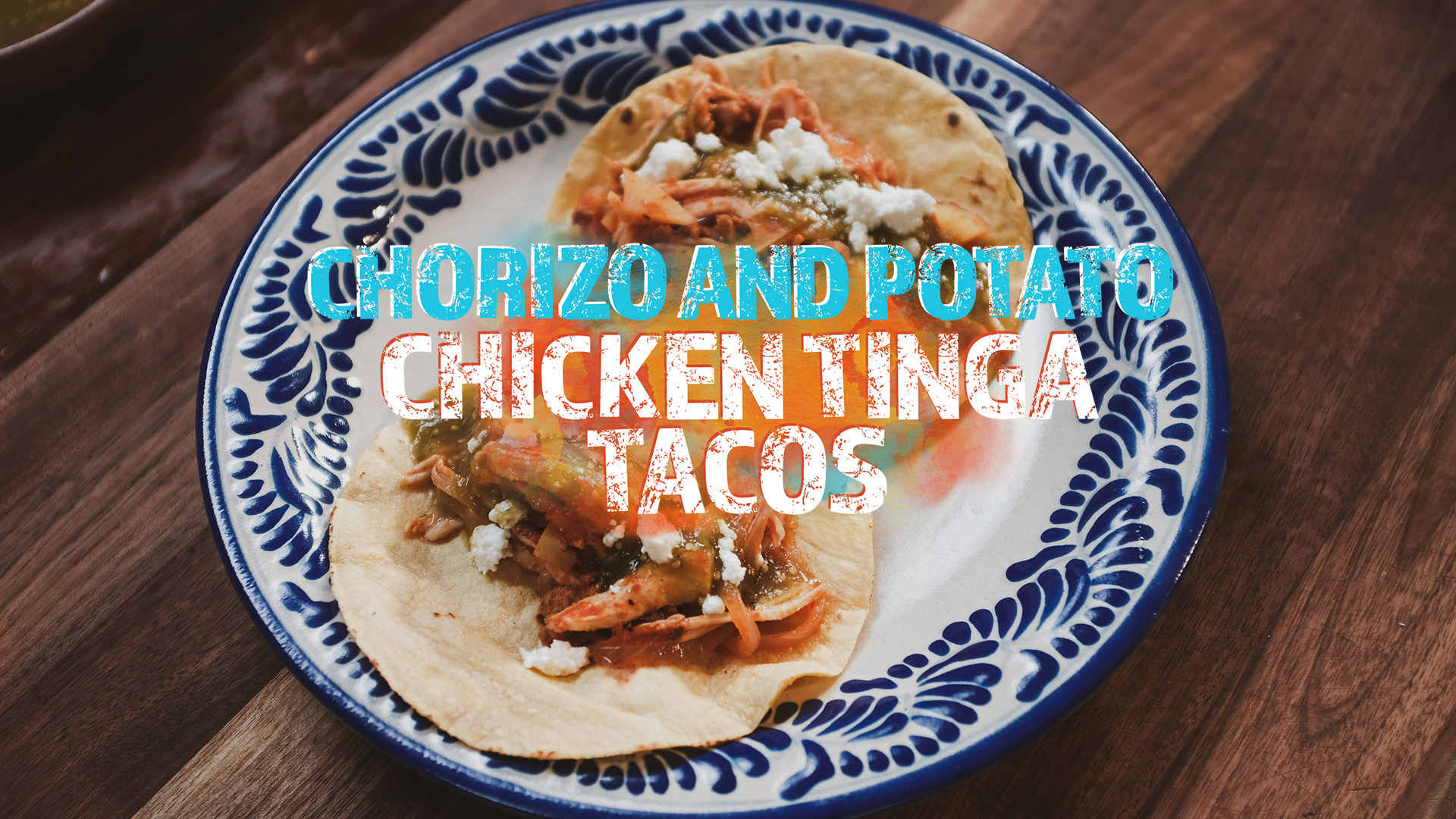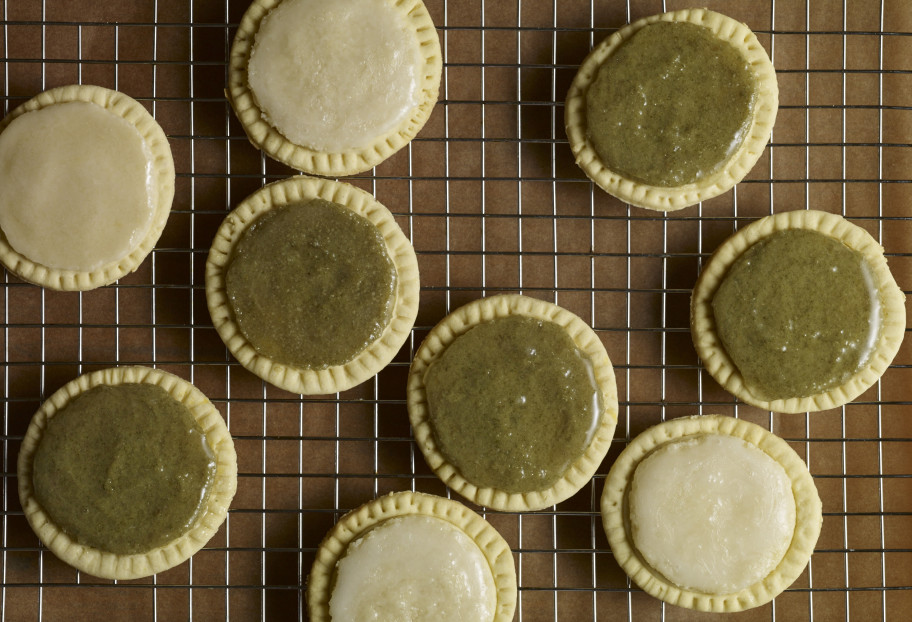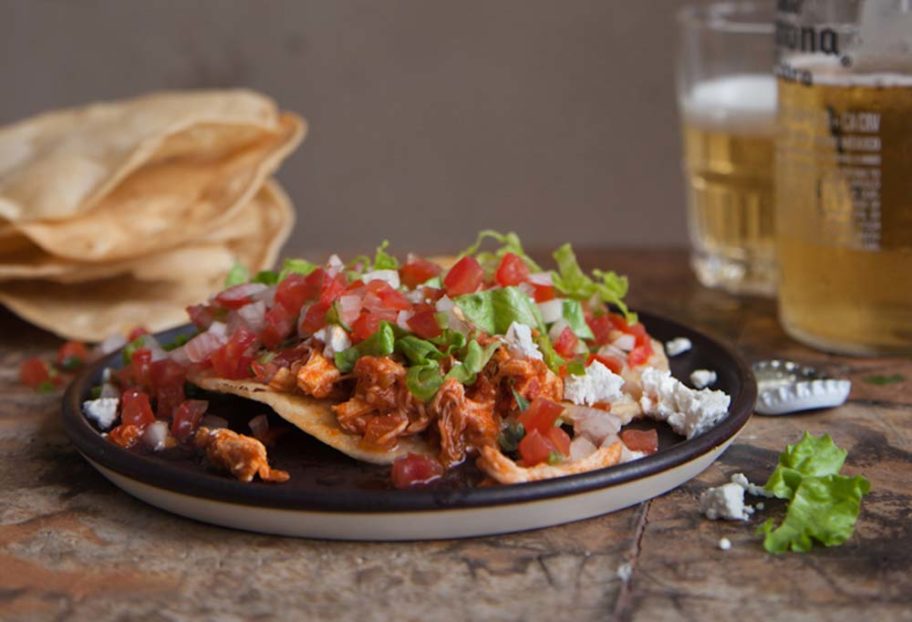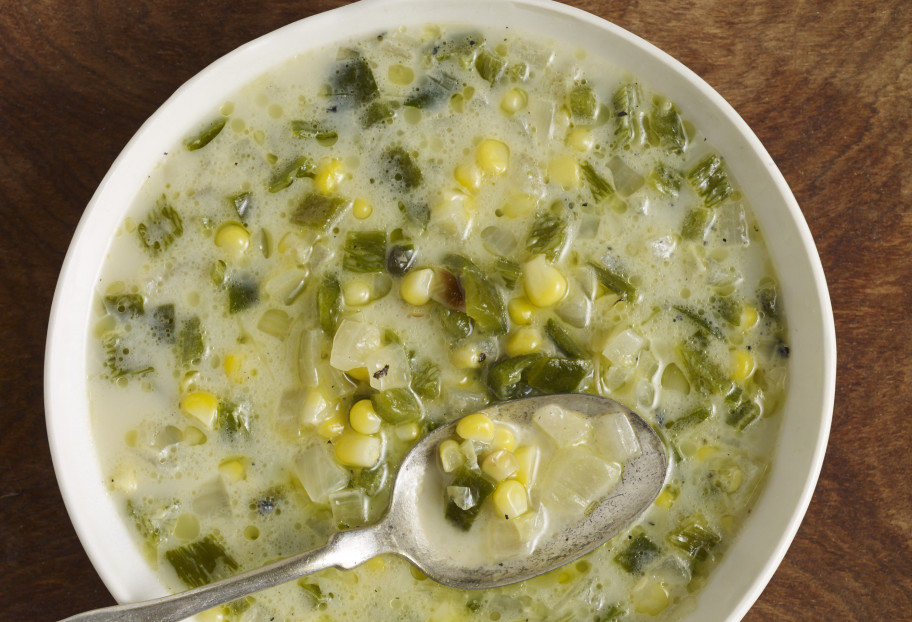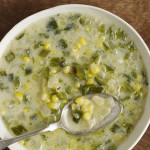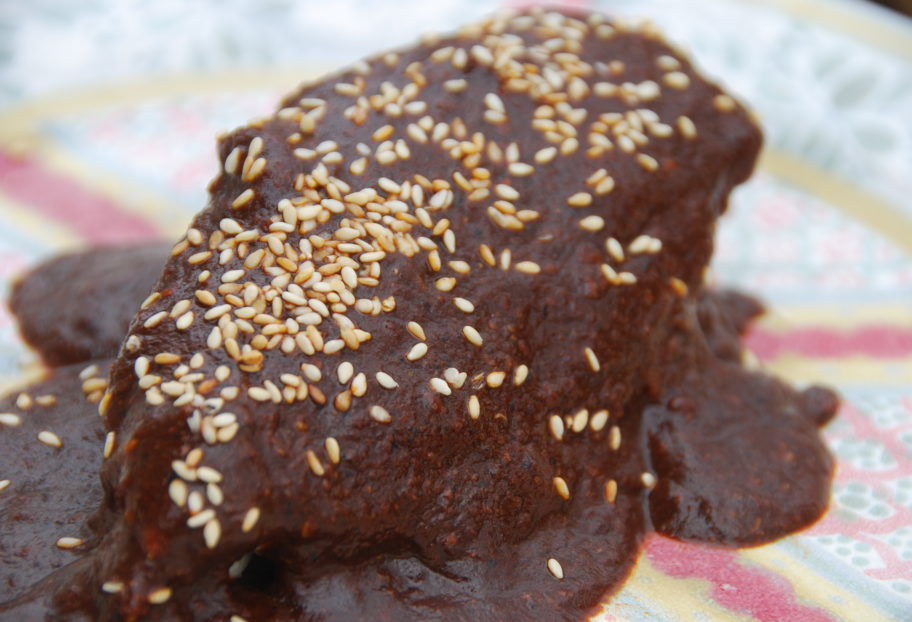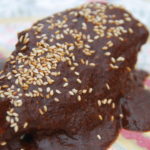Puebla
Glazed Santa Clara Cookies
Glazed Santa Clara Cookies
Ingredients
For the dough:
- 1 stick unsalted butter (4 oz)
- 1 cup confectioners' sugar
- 1/4 teaspoon baking powder
- 3 cups flour plus more for rolling out dough
- 3 egg yolks
- 1/2 cup lukewarm water
For the glaze:
- 2 cups sugar
- 1/2 cup water
- 3 cups raw and hulled pumpkin seeds or slivered almonds
- 1/2 cup milk
To blanch the pumpkin seeds:
- 1/2 teaspoon baking powder or baking soda
Instructions
To prepare the cookies:
- In the bowl of a mixer, beat the butter on medium speed until creamy. Reduce speed to lowest setting and gently add the confectioners’ sugar and baking powder. Continue mixing until everything is incorporated.
- Add the flour, one cup at a time, and then the egg yolks, one at a time; continue beating for a minute. Pour in the water and continue mixing until the dough is smooth and can form a ball. Wrap the dough in plastic wrap and place it in the refrigerator. Let it cool until it hardens enough to be manageable, at least 1/2 hour (can refrigerate up to a couple of days).
- When ready to bake, preheat the oven to 375 degrees and cover a baking sheet with parchment paper.
- Place half the dough on a piece of lightly floured parchment paper, sprinkle some flour over it and then place another piece of parchment paper on top. Use a rolling pin to gently roll out the dough, to about 1/4-inch thick. Remove the top piece of parchment paper and cut out circles with a round, 3-inch cookie cutter. With a smaller cookie cutter, make a circular indention in the middle of each cookie, without cutting all the way through the dough (there should be about a 1/4-inch space between the indentation and the edge). Press the edges of each cookie with a fork, as if marking the edges of a pie. Repeat the process with the remaining dough and roll it out again, making as many cookies as possible.
- Space the cookies at least 1/4-inch apart on a cookie sheet and bake for about 10 minutes, until they are fully cooked and the bottoms are lightly browned. Remove from the oven and let cool; repeat with the remaining cookies.
To prepare the base for the glaze:
- To make the candied pumpkin seed glaze white, as the nuns of the Santa Clara convent traditionally used to, prepare the pumpkin seeds this way:
- Bring water to a boil in a small saucepan, add pumpkin seeds, simmer about 5 minutes and turn off the heat. Let it cool, stir in baking soda or powder and let it sit overnight. With your hands, rub the pumpkin seeds between your fingers and thumbs to try to release their skins. The skins will float in the water. Carefully pour off the water, cover again with clean water and drain again. With a slotted spatula, place the pumpkin seeds on a clean kitchen towel, rubbing them so that the remaining skins come entirely off. Place the seeds in a bowl, cover them with water, rinse and place them on a cloth towel or paper towels to dry.
To make the pumpkin seed glaze:
- To make the candied pumpkin seed glaze green, which is a lot less work, prepare the seeds this way:
- Place hulled, unsalted pumpkin seeds in the jar of a blender or food processor and grind completely.
To make the a almond glaze:
- To make the a white glaze that’s even easier, just:
- Place already-blanched, slivered almonds in the jar of a blender or food processor and grind completely.
To prepare the glaze:
- In a medium saucepan, place the sugar and 1/4 cup of water over medium low heat. Cook until the sugar has completely melted into the water, is no longer granulated and appears to be light syrup, 8 to 10 minutes.
- Add the ground pumpkin seeds or almonds and stir well, creating a thick paste. Let the mixture cook for another 3 to 4 minutes — it will thicken and become even more pasty. Turn off the heat, pour in the milk and stir well. It should be thick yet shiny and a bit more liquid.
- Remove the mixture from the heat and let it cool until it slightly thickens and can top the cookie without spilling all over. It will spread as it settles, but if it has cooled enough it will not be too runny. Yet, before it completely cools and hardens. If it does harden, just heat the mixture over low heat with a tablespoon of water until it becomes runny again.
To assemble the cookies:
- Once the cookies have cooled, add about one tablespoon glaze to each cookie.
Notes
Chicken Tinga
Chicken Tinga
Ingredients
For the Chicken Tinga:
- 3 tablespoons safflower or corn oil
- 1/2 white onion slivered
- 2 garlic cloves chopped
- 8 roma tomatoes or 2 lbs, rinsed
- 2 tomatillos or 1/4 lb, husked and rinsed
- 1/2 teaspoon crumbled dried oregano
- 1/4 teaspoon dried marjoram
- 1/4 teaspoon dried thyme
- 1 1/2 teaspoon sea or kosher salt or to taste
- 1/4 teaspoon fresh ground black pepper or more to taste
- 2 tablespoons sauce from chipotle chiles in adobo sauce
- 1 whole chipotle chile in adobo sauce, optional
- 5 cups cooked shredded chicken
To Serve: quantities as desired
- Corn tostadas store bought or home made
- Refried beans
- Shredded iceberg lettuce
- Queso fresco or cotija crumbled
- Mexican avocado slices
Instructions
To make the Chicken Tinga:
- Place tomatoes and tomatillos in a medium saucepan, cover with water. Bring it to a simmer and cook for about 10 minutes, or until tomatoes and tomatillos are soft, thoroughly cooked and mushy but not falling apart.
- Remove tomatoes and tomatillos with a slotted spoon, and place them in the jar of a blender or food processor and process until smooth.
- Heat the oil in a large and deep pan over medium heat; once it is hot but not smoking, stir in the onion and cook until soft and translucent, for about 5 to 6 minutes. Stir in the garlic and cook until the onion and garlic mixture becomes fragrant and lightly browned, about 1 minute.
- Pour the tomato/tomatillo sauce on top and add the oregano, marjoram, thyme, salt, black pepper and the chipotle chiles in adobo sauce (if you want more heat add an entire chipotle chile in adobo sauce). Let it simmer, stirring now and then, until it seasons and deepens to a deep red color, about 10 to 12 minutes. You may want to partially cover the pan as the sauce will want to jump out onto your burners.
- Add the shredded chicken and combine it with the sauce. Let it cook, occasionally stirring, until the chicken has absorbed almost all of the juices and the mixture is moist but not juicy.
To assemble the Tostadas:
- Spread refried beans on a tostada, add the chicken tinga mixture, top with shredded lettuce, avocado slices, crumbled cheese and, if you want some, cream too. You may also serve with salsa verde on the side.
Notes
Creamy Poblano Soup
Creamy Poblano Soup
Ingredients
- 2 tablespoons unsalted butter
- 2 tablespoons vegetable oil
- 2 cups white onion chopped
- 5 to 6 poblano peppers roasted, sweated, peeled, seeded and diced
- 2 cups corn kernels fresh or thawed
- 1/2 teaspoon kosher or coarse sea salt or to taste
- Freshly ground pepper to taste
- 3 cups chicken broth
- 1 cup milk
- Queso fresco, crumbled optional
Instructions
- Place a large soup pot over medium heat; add oil and butter. Once the butter melts and begins to sizzle, add the onion and cook, stirring occasionally, until the onion has completely softened, and the edges have begun to brown, about 10 to 12 minutes.
- Add the poblano chiles, stir and let them cook for 3 to 4 minutes. Make some room in the middle of the pot, and add the corn, sprinkle the salt and pepper and cook for another 3 to 4 minutes.
- Pour in the chicken broth, let it come to a simmer and cook for 5 more minutes, so that the flavors have had the chance to really blend.
- Reduce the heat to low, wait for about a minute, and gently pour in the milk. Heat the soup through, for about 6 to 8 minutes, and serve. If you make it ahead of time, and want to reheat it, do so over low-medium heat.
Notes
Mole Poblano: Yes You Can!
The showcase of last week’s class was one of Mexico’s most famous and delicious moles, the Poblano, which originated in the kitchen of the Convent of Santa Rosa, in Puebla. After seeing how much guests enjoyed it, I can’t wait to share it with you.
I know, the word Mole sounds exciting to eat yet intimidating to prepare. As the root of the word describes, from the náhuatl mulli, Mole is a thick sauce or paste made by grinding ingredients together in a molcajete or communal mill. A food processor works as well. This sauce can be thinned out with broth or water when ready to use.
The Poblano with its long ingredients list and its laborious process, is not the best way to introduce Moles. There are some simple Moles with no more than 4 or 5 ingredients that are easier to prepare and just as tasty.
But here I am! I adore the Poblano and I know you will too…
I tested many ways to find the easiest route to make it without compromising its authenticity and flavor. As long as you prep your ingredients and have them in place before you start throwing them in the pot -what the French call Mise en Place and Mexicans Estate Listo!-, it’s a manageable task that takes about an hour. Trust me. Here we go.
As I list the ingredients, we’ll go through some Mole basics…
Four chiles are typically used: The reddish Ancho (6 o’clock) with bittersweet and fruity flavors; the black Mulato (12 o’clock) with much sweeter, chocolaty and fuller tones; the raisin colored Pasilla (3 o’clock) with a deep, strong and bitter bite; and the tobacco looking Chipotle (9 o’clock) smoky, rich and spicy.
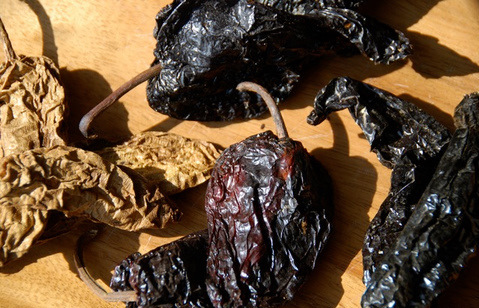
To be worthy of the name Mole, its not enough to be a sauce. You need chiles in there, but adding a Jalapeño doesn’t make it a Mole. Some chiles work together and some don’t. Some work for certain kinds of moles and some don’t. This group of four, is like the Fantastic Four.
The Mole Poblano has the deep clean flavors from the white onion, a judicious use of the pungent garlic, the refreshing punch from the tomato and the tartness of the tomatillo.
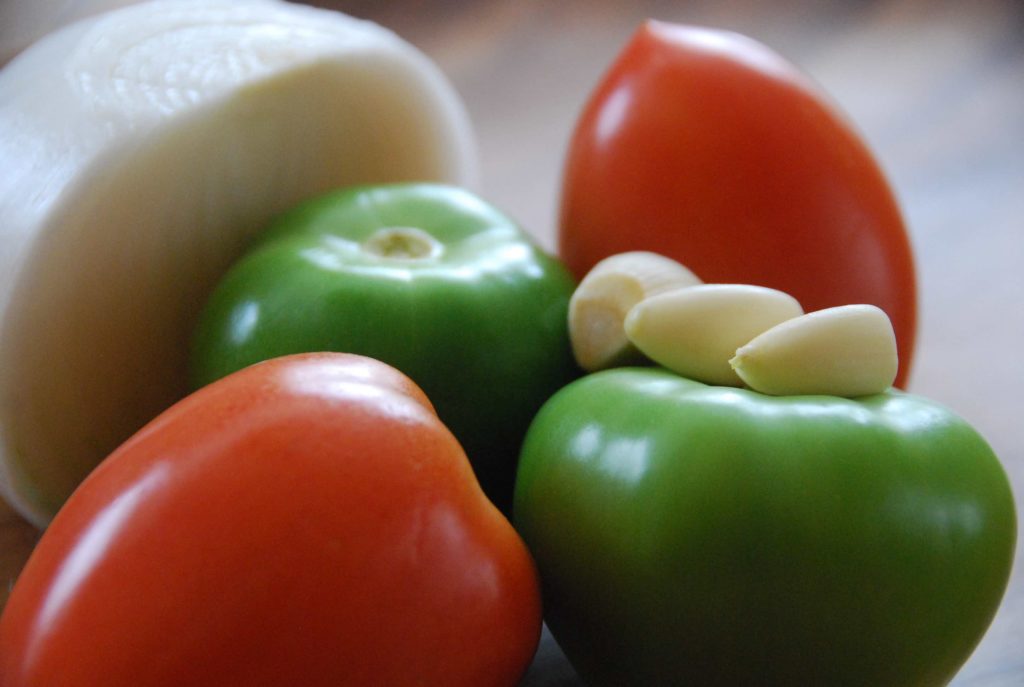
Moles show a deep intermarriage between the native Mexican cuisine and that brought from Spain. Three centuries of Colonial life deeply influenced our food. That’s the case of the onion, garlic and many of the nuts, fruits and spices added below.
Native peanuts and pumpkin seeds which are present as a thickener and flavoring element in many Mexican dishes, add some Mediterranean almonds, a bunch of sweet raisins…
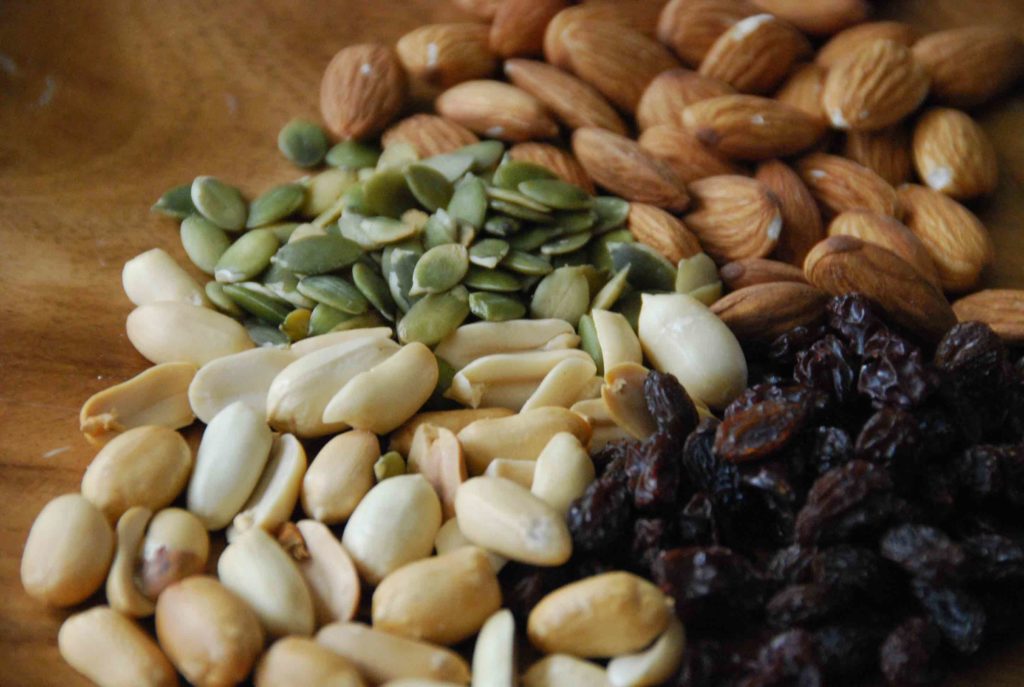
Chile seeds tend to be discarded in many Mexican dishes, but not in this Baroque concoction from the late 1600s. Seeds do store most of the heat from chiles but also a ton of their flavor.
They are beautiful too, especially in my grandmother’s bowl which photographs so nicely…
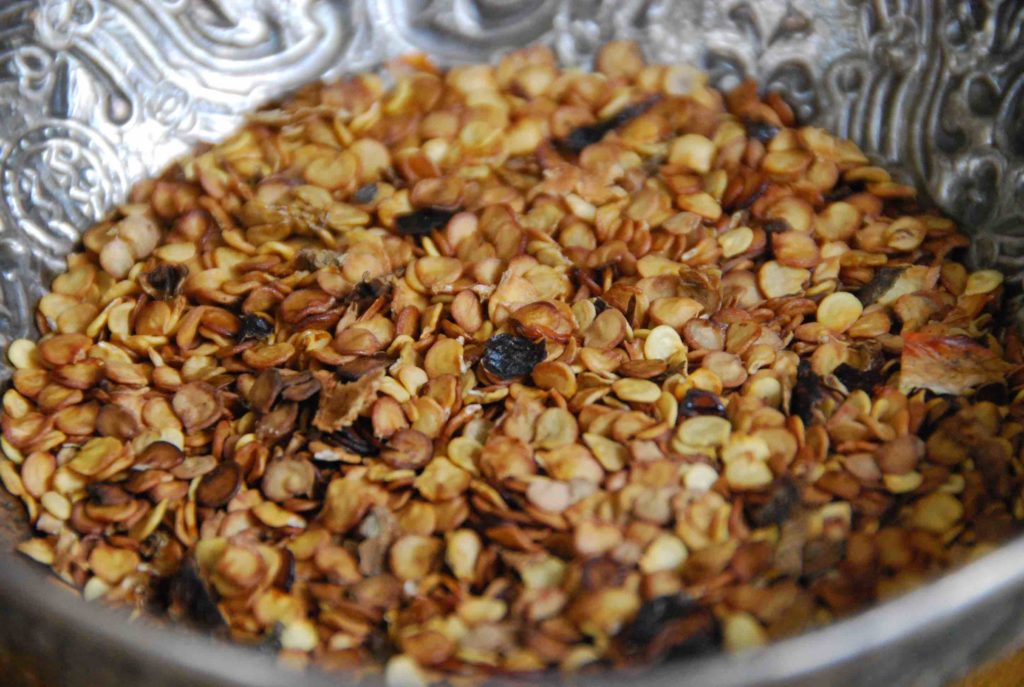
Other seeds and spices included take a ride through Mexico’s history: Sesame seeds brought by African slaves; anise seeds, cloves, cinnamon and black peppercorns from the Orient routes; allspice from the Caribbean; coriander, thyme and marjoram from the Mediterranean…
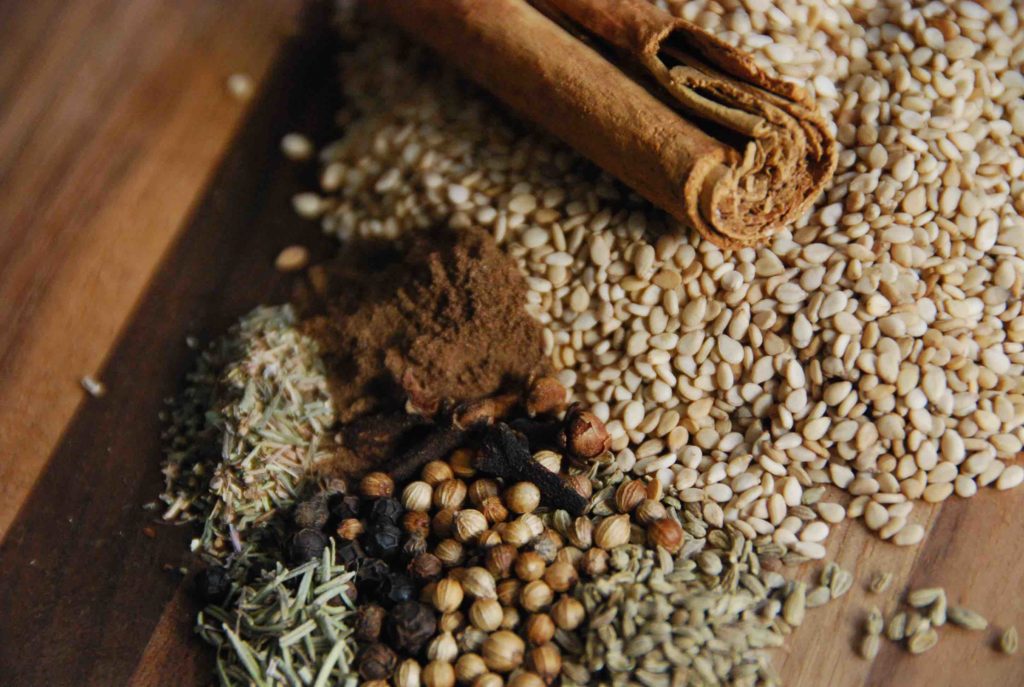
To thicken the Mole and to add an earthy base with a small town flavor, corn tortillas are used. As well as Mexican style bread -bolillos or teleras which are the Mexican adaptation of the French baguette from the times of Maximilian.
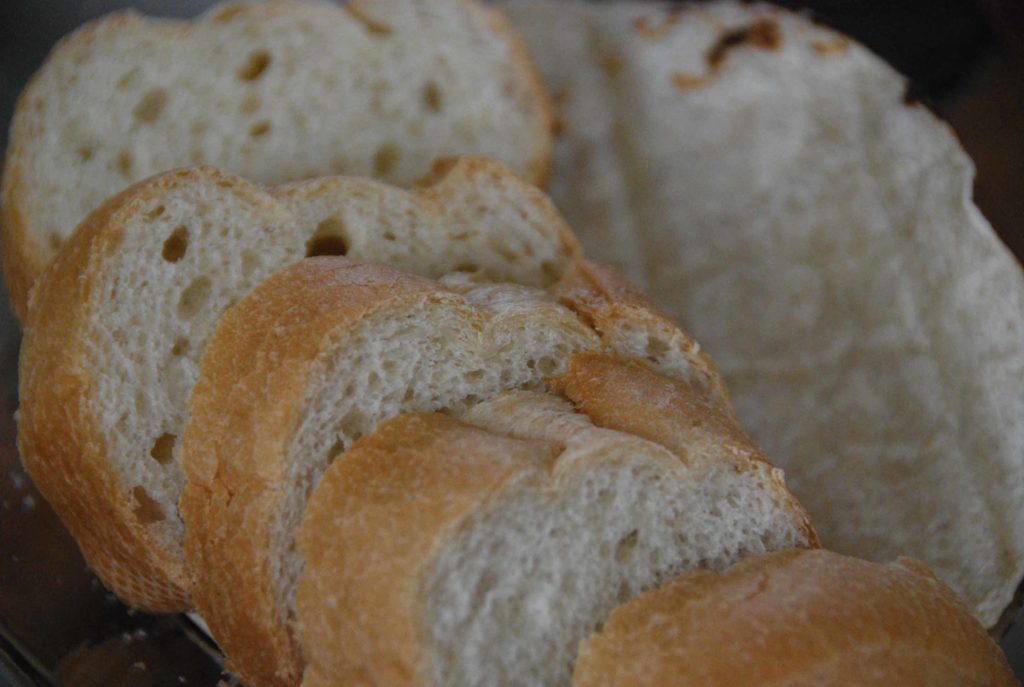
To top the balancing act of this dish, and also because it was created by Sor Andrea de la Asunción, a nun with an incredible sweet tooth, Mexican chocolate is added. Made with toasted cacao, cinnamon, sugar and typically ground almonds, it is sweeter and grainier than regular bittersweet chocolate.
Not that much chocolate is added though, so the idea that the Mole Poblano is a chocolate sauce is a bit exaggerated…

Now that we ran through the ingredients, let’s cook it. As we do, you will see that another Mole quality is that ingredients are transformed, and their qualities brought out, before they are pureed together. That helps achieve such a smooth layering of complex flavors.
First add lard, vegetable shortening or oil in your pot. Once hot, saute the chiles until crunchy and browned. Remove with a slotted spoon and place in a bowl. They will look something like this…
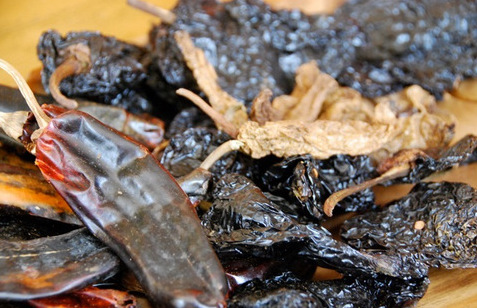
In that same pot add the onions and garlic and cook until softened, for about 2 to 3 minutes.
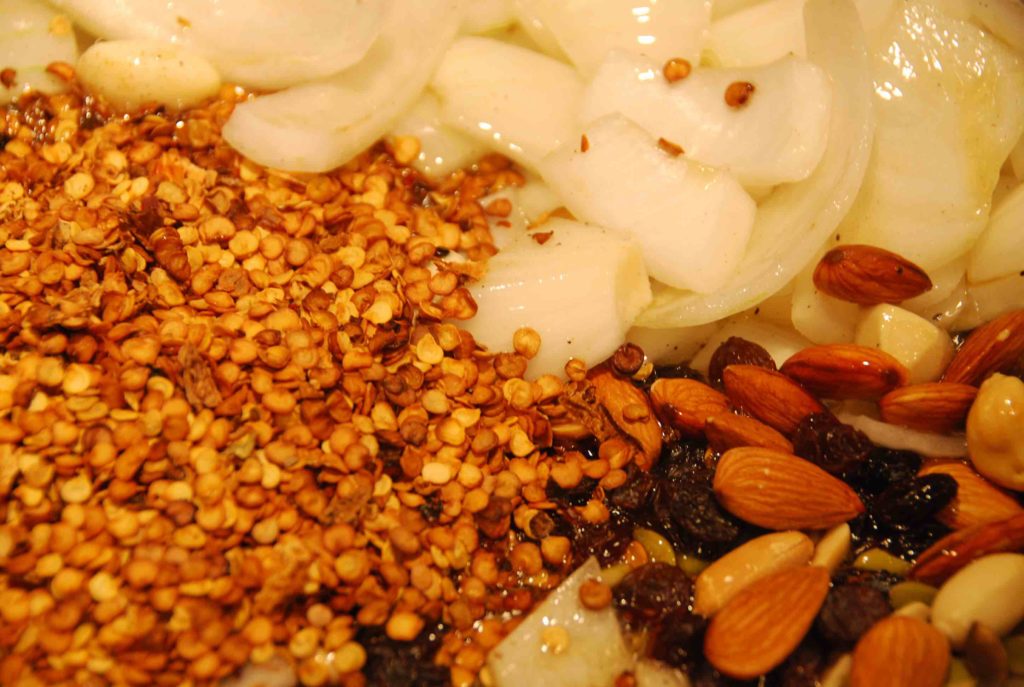
Make some room and toss in the almonds, peanuts, raisins and pumpkin seeds, cook for another 2 to 3 minutes more…
Some versions of this mole ask that ingredients be charred, broiled, toasted, sauteed, ground one by one, even with different pots and pans. But you can use the same pot as long as it is heavy, large and extended and as long as you give the ingredients enough time before adding the next batch…
So, make some room again to throw in those beautiful reserved chile seeds… AND…
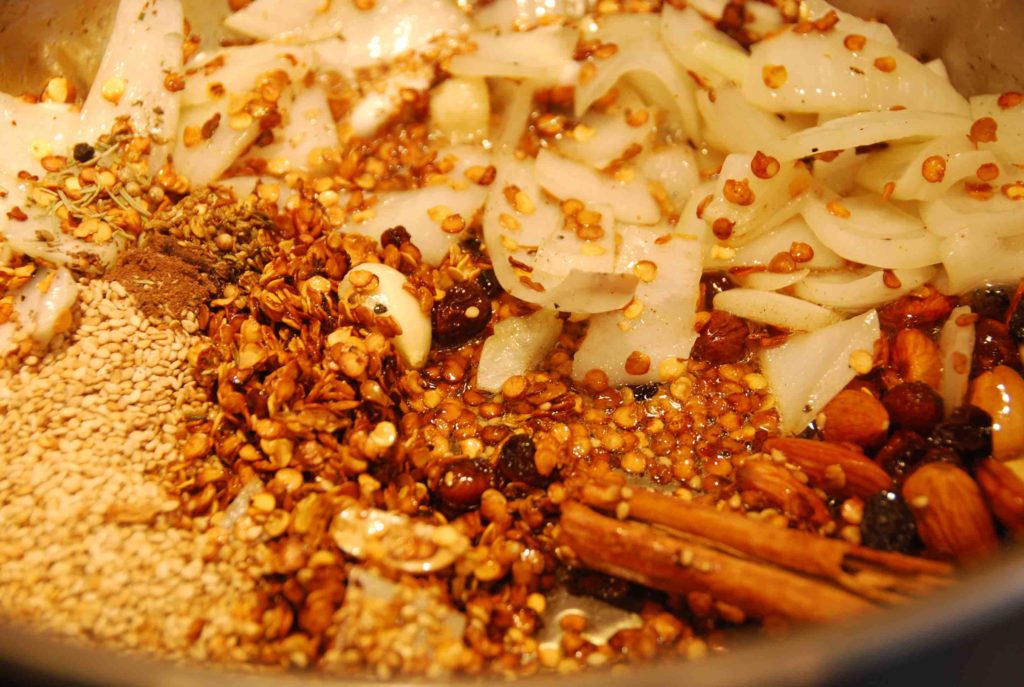
…sesame seeds,stemmed cloves, anise seeds, coriander seeds, black peppercorns, cinnamon stick, ground allspice, thyme and marjoram. Let it all cook for 4 to 5 minutes.
Make some room again, and add the already charred or broiled tomatoes and tomatillos, the sliced tortillas and bread…
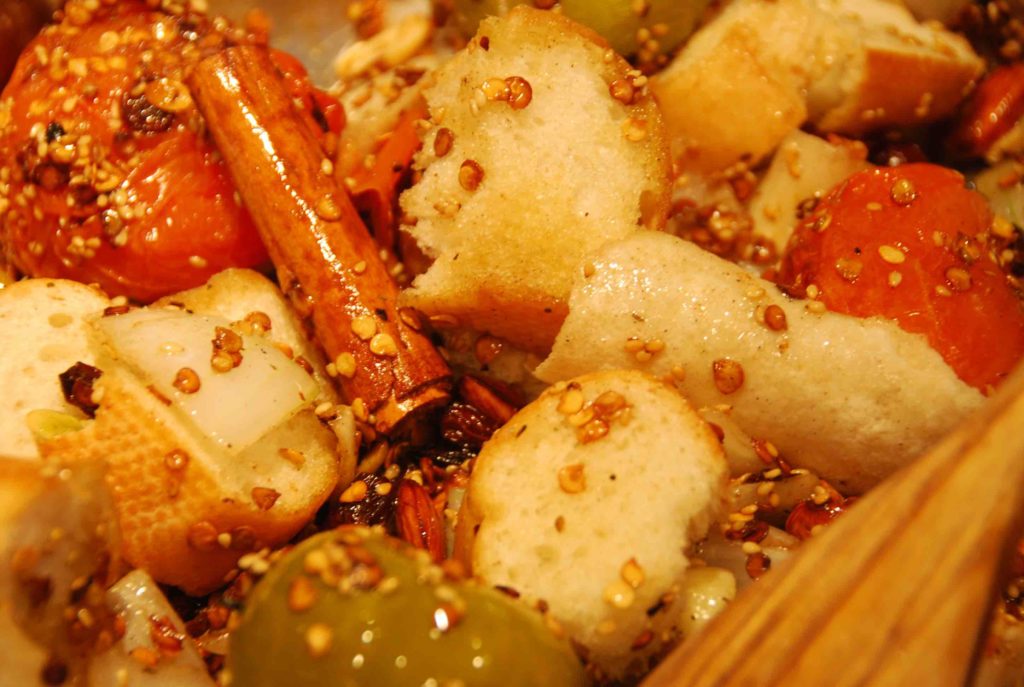
As you add each additional batch of ingredients, give them time to season and brown together. Don’t let any of them burn though…
Go ahead and add the chiles that you already browned, and mix it all up.
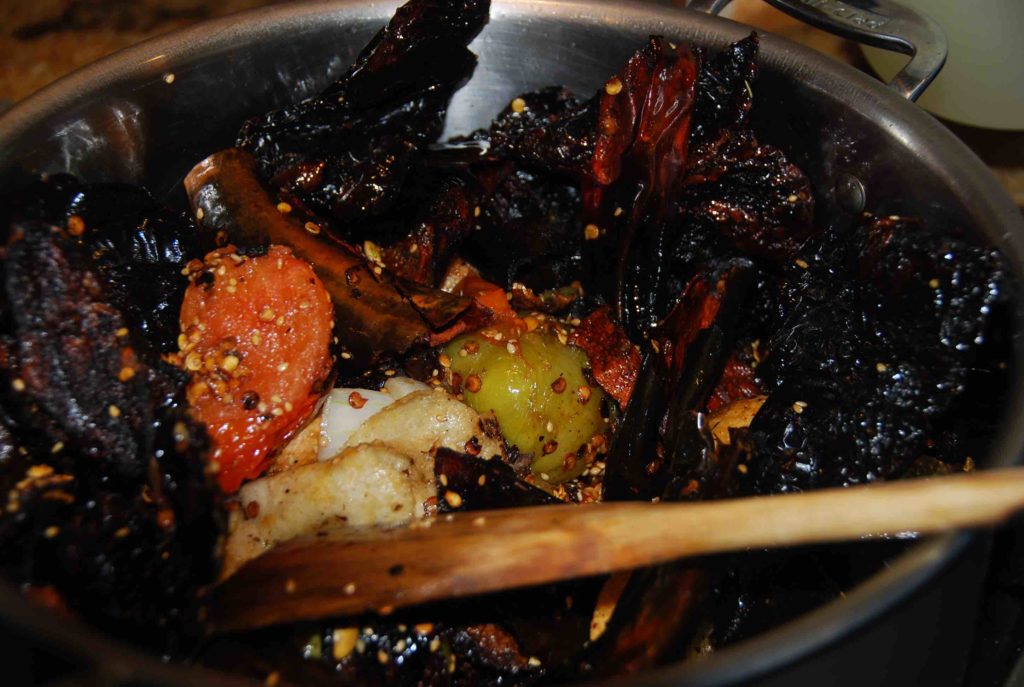
Pour in some rich tasting chicken broth.
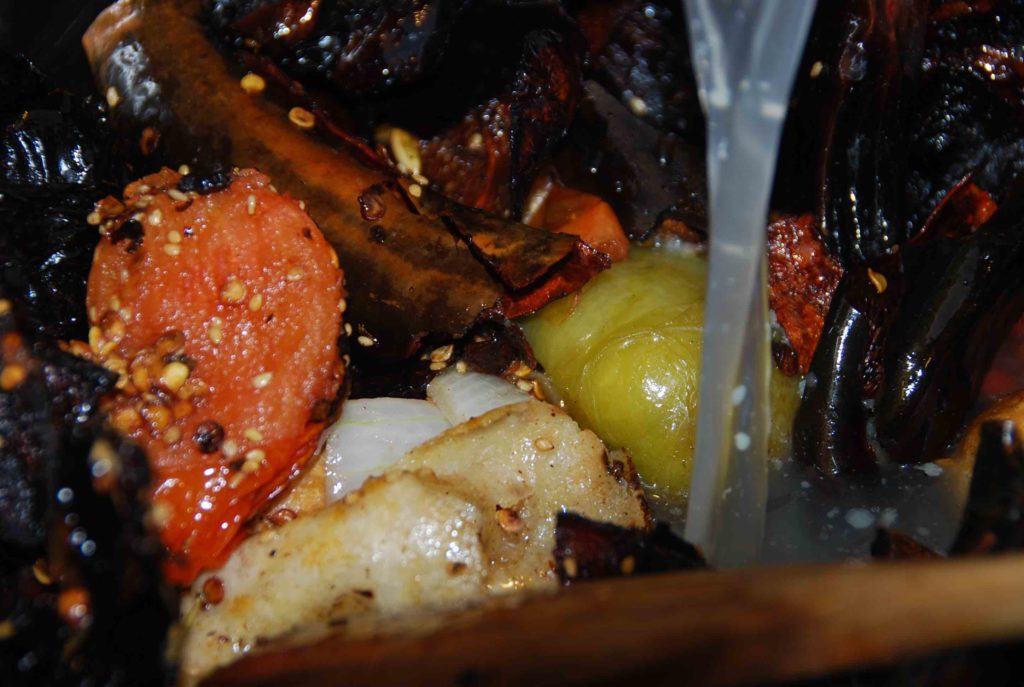
Once it starts to simmer, drop in the chocolate pieces and stir until they dissolve.
Look at the gorgeous looking mess that we have here below!!!
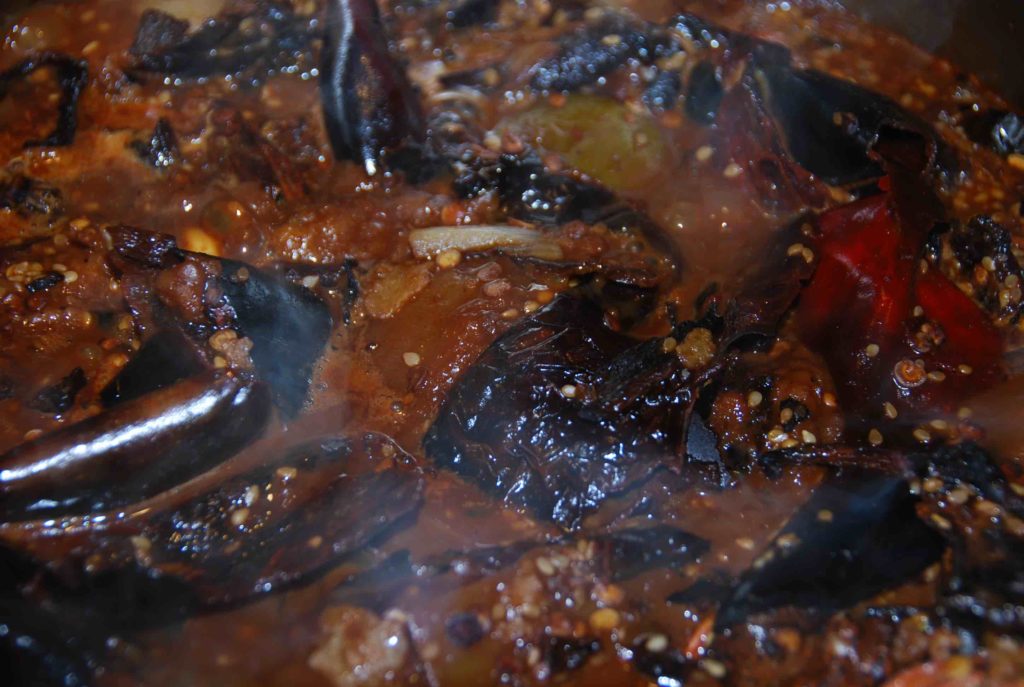
Let it all simmer for about 15 minutes. You have quite a diverse group of ingredients in there, so they need a bit of time to get acquainted with each other…
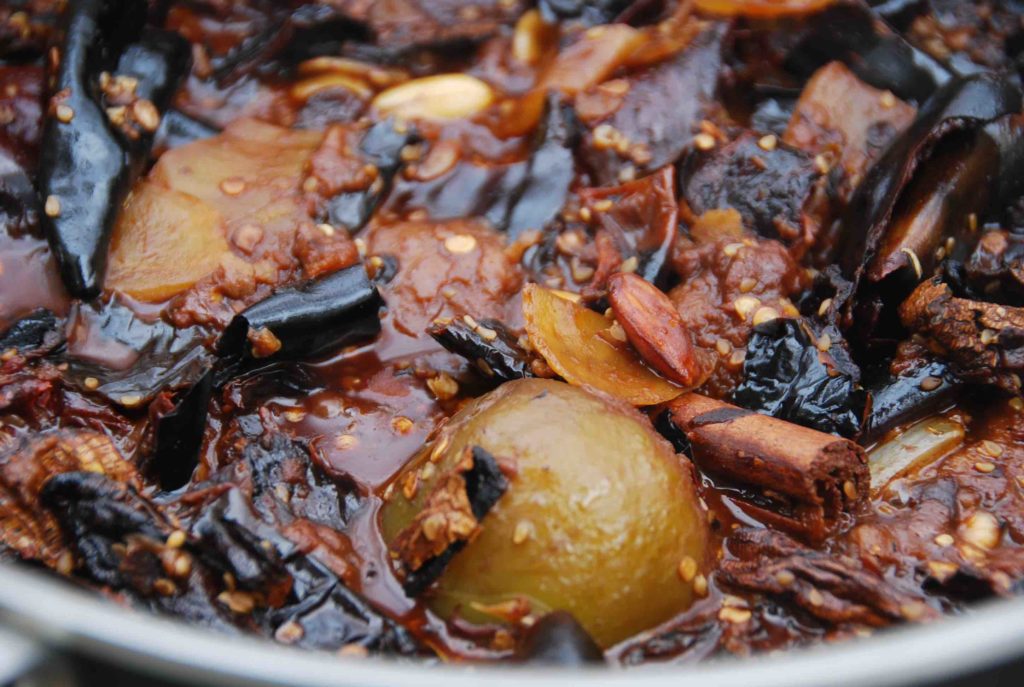
Turn off the heat and let the mixture stand, so it can make sense of what it will become.
Then, puree in a food processor or blender. Or why not, if you feel like it, take out that molcajete.
Finally, thank Sor Andrea for what you are about to see!!! The tastiest, yummiest…
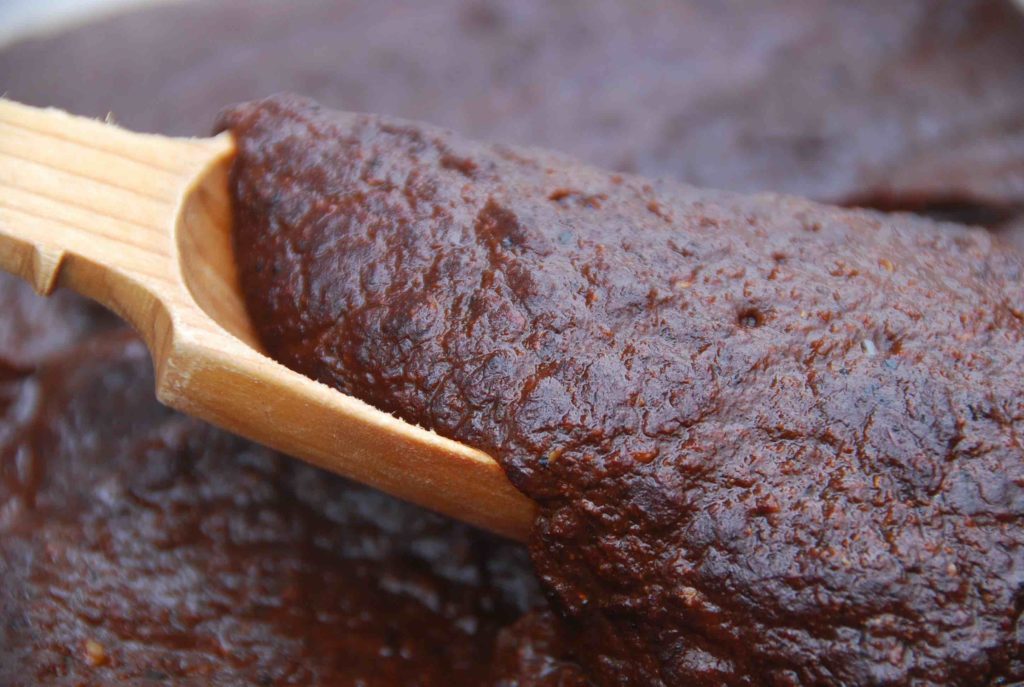
Let’s just say: one of my favorite Moles.
Of the many things you can make with this mole such as enchiladas, enmoladas, empanadas, eggs, nopales or potatoes.. there’s of course the traditional: poured over simply boiled chicken or turkey and covered with lightly toasted sesame seeds.
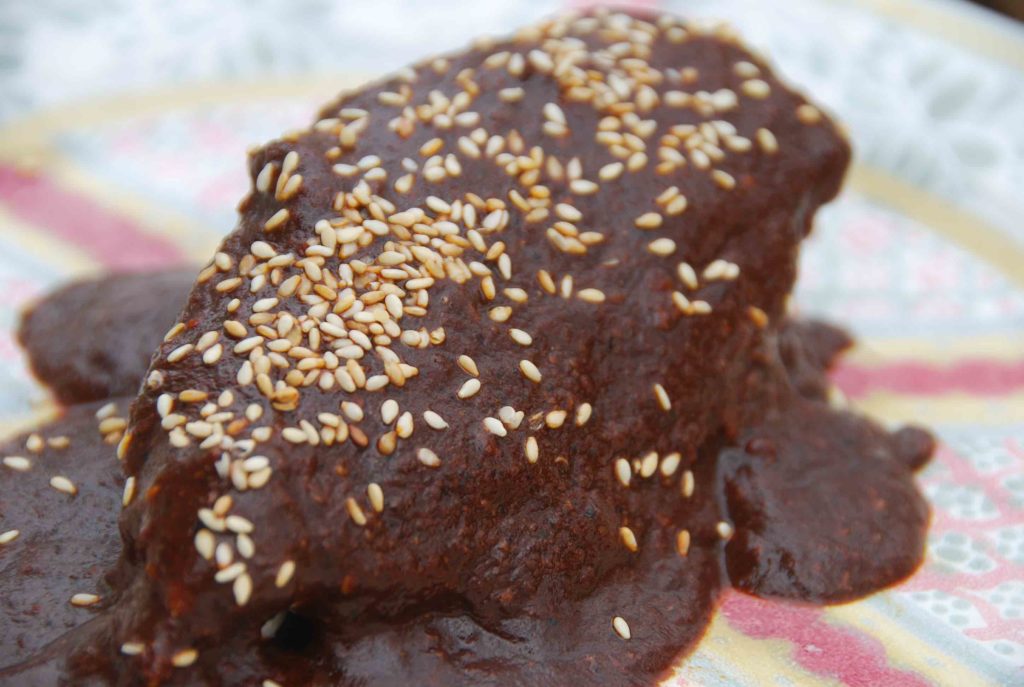
You can see why I took longer to post this time: I was too busy adding ingredients to the basics section of my blog, just for this recipe!
Mole Poblano
Ingredients
- 1/2 cup lard vegetable shortening or vegetable oil
- 3 ounces chiles anchos about 6 or 7, stemmed and seeded
- 3 ounces chiles pasillas about 12 or 13, stemmed and seeded
- 3 ounces chiles mulatos about 6, stemmed and seeded
- 1/3 ounces dried chipotle chiles about 4, stemmed and seeded
- 1/2 white onion about 1/2 pound, roughly chopped
- 3 garlic cloves peeled and roughly chopped
- 3 tablespoons raw almonds with skin
- 3 tablespoons raw shelled peanuts
- 3 tablespoons raisins
- 1 tablespoon pumpkin seeds
- 4 tablespoons sesame seeds
- 1/2 cup reserved chile seeds
- 5 whole cloves stemmed
- 1/4 teaspoon anise seeds
- 1/4 teaspoon coriander seeds
- 1/2 teaspoon whole black peppercorns
- 1 stick true or ceylon cinnamon
- 1/4 teaspoon ground allspice
- 1/8 teaspoon dried thyme
- 1/8 teaspoon dried marjoram
- 1/2 pound roma tomatoes about 2 , charred or roaste
- 1/3 pound tomatillos about 2, husked, rinsed, charred/roasted
- 2 corn tortillas sliced into 8 pieces
- 1/2 bolillo telera or baguette, about 2 ounces, thickly sliced (if it is a couple days old, better)
- 6 ounces Mexican style chocolate or bittersweet chocolate
- 5 cups chicken broth plus 4 more to dilute later on
- 1 teaspoon kosher or sea salt or more to taste
- 1/2 cup sesame seeds toasted, to sprinkle at the end
Instructions
- In a large extended casserole dish set over medium high heat, add 1/2 cup lard, oil, or vegetable shortening. Once hot, about 2 minutes later, add the chiles in 2 or 3 batches and saute, stirring often, and being careful not to let them completely burn. Remove with a slotted spoon and place in a mixing bowl as you move along.
- In the same oil, add chopped onion and garlic and saute for 2 to 3 minutes, stirring, until they soften and release their aroma. Stir in the almonds, peanuts, raisins and pumpkin seeds, and let them cook for 2 to 3 minutes.
- Stir in the sesame seeds, reserved chile seeds, stemmed cloves, anise seeds, coriander seeds, black peppercorns, cinnamon stick, ground allspice, thyme and marjoram. Stir frequently and let it all cook for 3 to 4 more minutes, stirring often. Make room again, and add the tortilla and bread pieces along with the tomatoes and tomatillos. Let it all cook for a couple minutes.
- Incorporate the already sauteed chiles and pour in the chicken broth. Stir and once it comes to a simmer, add the chocolate pieces and the salt. Mix well, and let it simmer for 12 to 15 minutes. Turn off the heat, cover and let the mix rest for 1/2 hour, so the chiles can completely soften.
- In batches, puree the mixture in the blender or food processor until smooth. You can store this mole, covered, in the refrigerator for up to a month, or freeze it for up to a year.
- When ready to eat, dilute a cup of mole with 1/2 cup chicken broth in a saucepan and simmer for 2 to 3 minutes. Serve over cooked chicken or turkey and sprinkle with toasted sesame seeds on top.
Notes
Puebla
A main culinary hub where many of Mexico’s most iconic dishes originated and the home of Cinco de Mayo
Located in east-central Mexico, Puebla’s origins as a state stem from the city of Puebla, which was founded by the Spanish in the 16th century as a major hub on the trade route between Mexico City and the port of Veracruz. This brought in many foreign ingredients that were combined with indigenous ingredients, often by nuns in the convents, to create many of Mexico’s most iconic dishes — mole poblano, chiles en nogada, tinga, and tortitas de Santa Clara to name a few. Cinco de Mayo, now a worldwide celebration of Mexican culture, also has its roots in Puebla, where it’s celebrated annually to mark the victory of Mexican forces over the French in the Battle of Puebla on May 5, 1862.

